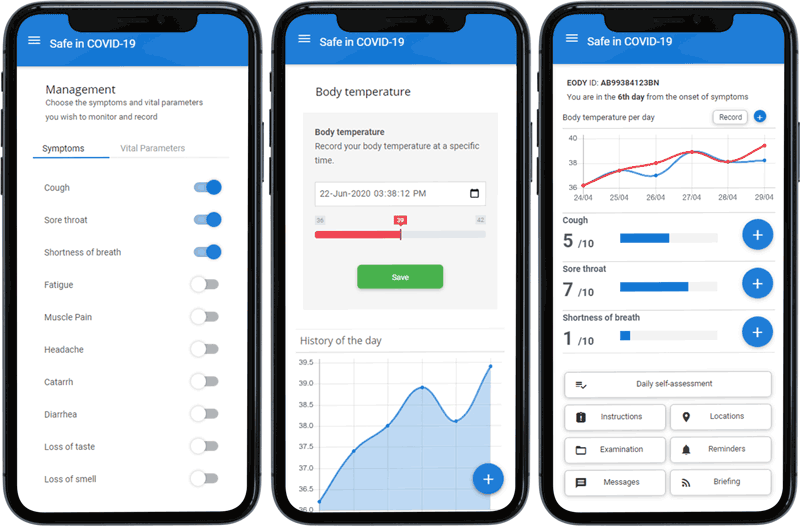by Haridimos Kondylakis, Dimitrios G. Katehakis and Angelina Kouroubali (FORTH-ICS)
We protect the community. We protect ourselves. We decongest the health system. We stay safe in COVID-19. One of the many responses to the global call against the world pandemic of COVID-19 resulted in “Safe in COVID-19”, an electronic platform developed by the Institute of Computer Science of the Foundation for Research and Technology – Hellas (FORTH-ICS), which is intended for tracing suspect, probable and confirmed incidence cases.
The ongoing coronavirus pandemic is affecting the lives of millions of people, while changing society by establishing new norms for social life, business and travel. The digital health domain has responded rapidly to the challenges presented by the coronavirus disease 2019 (COVID-19) pandemic, delivering multiple health apps [1] designed for training, information sharing, risk assessment, self-management of symptoms, contact tracing, home-monitoring and decision making [L1].
In response to calls from the international community [L2], the Centre for eHealth Applications and Services of FORTH-ICS developed “Safe in COVID-19” [2][3], a set of digital tools unified under a single platform focusing on artificial intelligence (AI), semantics and data management. The platform, which is based on pre-existing work on personal health record systems and integrated care solutions, is designed to support personal health management and public health.

Figure 1: The mobile app |FORTH-ICS developed for Citizens staying “Safe in COVID-19” (in Android/iOS).
“Safe in COVID-19” has been designed to support the needs of public authorities, health professionals and individuals. It allows public authorities to gain a better overview of the distribution of suspect, probable and confirmed COVID-19 cases through real-time statistics. The platform provides citizens with self-assessment tests to help them keep track of their health, and access to reliable personalised information and instructions with the ability to have direct contact with healthcare professionals. Healthcare professionals can gain access to digital tools to facilitate the management of COVID-19 cases and communication with patients, tailoring medical advice on patient reported status. Citizens and their families can use “Safe in COVID-19” to record their vital signs and keep track of any symptoms that might be related to COVID-19, as part of the contact tracing process.
“Safe in COVID-19” consists of three applications for different user groups: public health authorities (web app), healthcare professionals (web app), and citizens (mobile app) [L3]. The web app for public health authorities aims to give a complete picture of the spread of the disease at a national level and the measures taken by healthcare services. It provides real-time detailed data about suspected, probable and confirmed cases; information that is useful for the surveillance of COVID-19 case distribution. The web app for healthcare providers supports online communication with registered patients to provide personalised information and coaching, and instant access to patient-reported symptoms related to COVID-19 in case of confirmed cases or symptoms that might be related to COVID-19 for probable or suspect cases. This app also supports the recording of COVID-19 laboratory test results. The mobile application for citizens supports the ability to keep daily records of health status and communicate synchronously or asynchronously with healthcare professionals in order to receive personalised instructions for health management.
Initially, the patient registers on the platform and provides self-assessment information based on a questionnaire for underlying diseases related to COVID-19 (chronic lung disease, severe heart disease, immunosuppression, diabetes, renal failure, liver failure and morbid obesity). The patient receives daily prompts to record any symptoms that might be related to COVID-19 and further self-assessment information using a visual analogue scale (VAS). These include cough, sore throat, shortness of breath or difficulty of breathing, fatigue, muscle pain, headache, runny nose or nasal congestion, diarrhoea, and loss of taste or smell. The patient can record vital parameters related to COVID-19 (body temperature, oxygen saturation SPO2, breathing rate, systolic and diastolic blood pressure and heart rate). Reminders for monitoring symptoms and vital parameters based on medical history and symptomatology help patients to stay safe at home. The app also facilitates patient access to laboratory test results.
All data are stored in a data lake, semantically uplifted and annotated using standard health ontologies. In addition, fast healthcare interoperability resources (FHIR) have been used to represent the medical data related to COVID-19. Based on the collected data, AI algorithms and epidemiological models can make predictions about how the virus is spreading in each geographic region, combining regional, country and health-system data. Instead of raw data, AI services are able to work directly on semantically uplifted data, exploiting the semantic correlation in the available data.
We anticipate that “Safe in COVID-19” will help public health authorities by easing the pressure on healthcare units, providing real-time information about the evolution of suspected, candidate and confirmed cases, providing online monitoring of the spread of the virus, and helping with decision-making regarding measures such as ordering a test or an onsite visit. Benefits for citizens include systematic recording of symptoms, self-assessment, access to personalised information, and instructions and reminders based on overall health status. Benefits to healthcare professionals include support in managing patients, reduced time in direct contact with patients, more efficient case management, and improved working conditions.
Links:
[L1] https://covid19.forthehealth.gr/
[L2] https://www.who.int/emergencies/diseases/novel-coronavirus-2019
[L3] https://covid19.forthehealth.gr/?page_id=962&lang=en
References:
[1] H. Kondylakis, et al.: “COVID-19 Mobile Apps: A Systematic Review of the Literature”, JMIR, 2020.
[2] D. Katehakis, et al.: “An outbreak response tool to effectively support surveillance of suspect, probable and confirmed incidence cases while staying safe in COVID-19, BIBE, 2020.
[3] A. Kouroubali, et al.: “An eHealth platform for the holistic management of COVID-19”, pHealth, 2020.
Please contact:
Dimitrios G. Katehakis, FORTH-ICS, Greece










